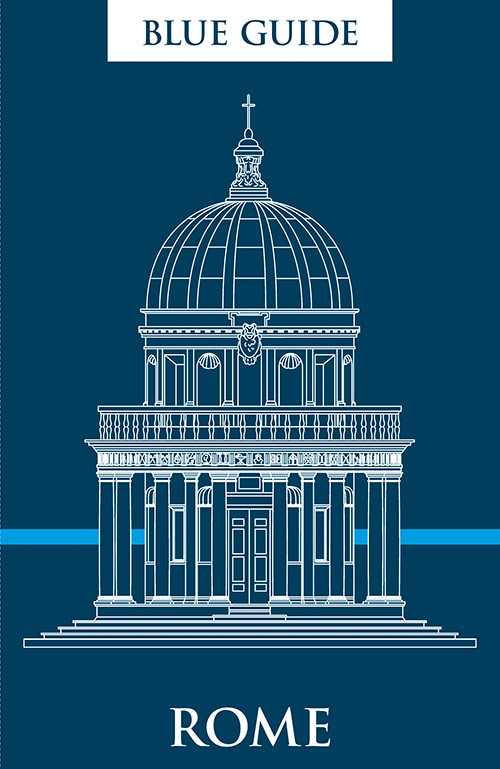
The most comprehensive guide to the eternal city, repository of many of the most famous works of art in the world.
View the book’s contents, index and some sample pages, and buy securely from blueguides.com here »

The most comprehensive guide to the eternal city, repository of many of the most famous works of art in the world.
View the book’s contents, index and some sample pages, and buy securely from blueguides.com here »
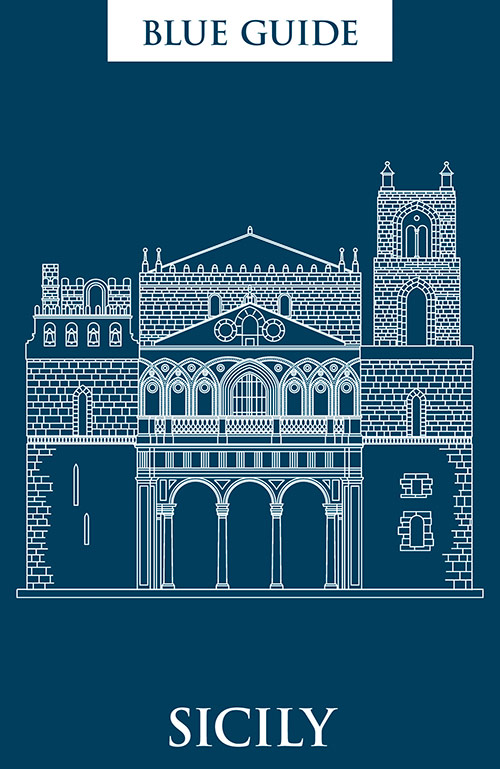
Sicily offers an enormous range of history: Greeks, Romans, Arabs and the Normans have all left their mark on a visually stunning landscape of volcanoes and vineyards.
Buy the book from blueguides.com here »
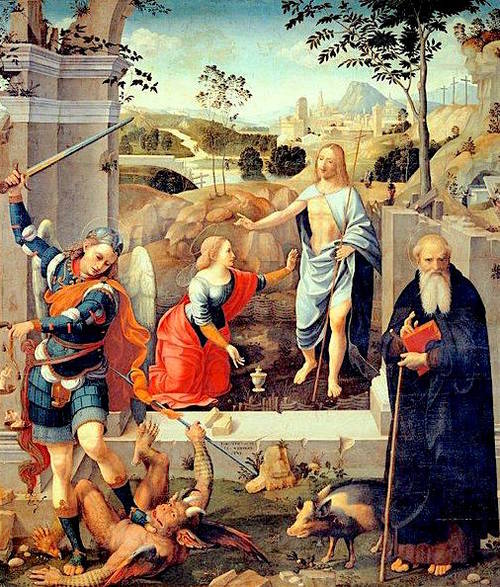
We were passing through Cagli and stopped there, drawn by the Blue Guide report of the La Gioconda which served us a wonderful lunch. It well deserves Ellen Grady’s accolade as ‘a fantastic little restaurant that will make you want to stay in Cagli forever’. Walking off our choices from the porcini menu, we discovered a treasure: halfway between the central square of Cagli, Piazza Matteotti, and the church of San Francesco, in the street named after the local 18nth century artist Gaetano Lupis, is a pretty 16th-century portico. There is a small oratory behind it. A fresh APERTO sign on the door entices you in, but in the first second as you enter, the oratory seems unlit. Then suddenly the altarpiece lights up, and there is this lovely painting by Timoteo Viti.
Viti was a native of Urbino, just a few years older than Raphael and a friend of both him and his father, although part of his training was in Bologna. He travelled widely in the Marche but collaborated with Raphael in Rome (in the church of Santa Maria della Pace) and this painting may reflect that influence. It appears freshly restored and shows Mary Magdalene reaching out towards the risen Christ. Between the two figures is the precious ointment mentioned in the gospels that was poured on Jesus by a woman, to the indignation of some of the onlookers. The woman is traditionally believed to be Mary Magdalene. Behind them is Jerusalem interpreted as if it were an Italian city of the day. The picture is enhanced by a richly-clothed Archangel Michael, the patron of the oratory, trampling on Lucifer and about to strike him with his sword. Opposite is the (4th-century) hermit St Anthony Abbot, with the pig that is a symbol of the medieval order of Hospitallers of which he was patron (the Hospitallers were allowed to support their work by raising pigs.)
It was a wonderful surprise to come across this painting and it should be included in the itinerary of all who visit this medieval town. As the oratory seems permanently open, one can visit it before or after lunch at La Gioconda!
by Charles Freeman, history consultant to the Blue Guides.
Brescia is well known for its wealth of Roman remains due to the unique urban development of the town after the demise of the Roman Empire. The original nucleus of the settlement at the foot of the Cidneo hill became crown property under the Lombards in the 8th century and was largely occupied by a religious foundation. Medieval Brixia expanded to the west around watercourses that came in handy as Roman aqueducts and sewers went out of use.
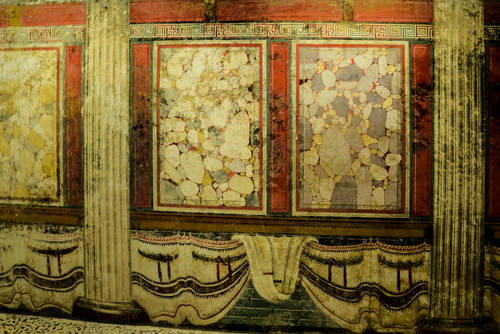
Later the area became available again and a number of fine town houses were built on top of the Roman remains, with frequent use of spolia. The Roman street grid was largely respected: today’s Piazza del Foro is the same shape and size as the Roman forum. At its north end, the creatively reconstructed Capitolium (open Tues–Sun 9–5.30,10.30–7 in summer; entry fee) with its three cellae, one each for Juno, Jupiter and Minerva, its podium and monumental steps, dominates the scene. All around the piazza, the Renaissance houses are known to have Roman remains in their cellars; the archaeological trail at Palazzo Martinengo on the west side of the square is an excellent introduction to the complex archaeology.
Recently a couple of new venues have been opened to the public. In the forum itself, one cella of the Republican Temple is now accessible. It had been known for some time that the Capitolium (1st century AD) was not built on virgin soil. Two earlier buildings had been identified. The Republican Temple (1st century BC) had been levelled and backfilled to make way for the new structure willed by the emperor Vespasian. In the process Rome took the decision to stamp out any localism. The four cellae of the Republican Temple (three for the Capitoline Triad, one for a local deity) were reduced to three for the Capitoline Triad only. The local deity was completely obliterated: its name is now not even known. Its cella, however, is the one that has survived best and is now open to the public. The statue of the deity may be missing from its podium at the far end but the loss is largely compensated for by vivid painted decoration (illustrated above) with sumptuous dadoes imitating fanciful breccia marble underscored by elegant drapery. The floor is the finest mosaic, stark white with a black band, made of minute tesserae. Fluted columns are either trompe l’oeil or brick covered in painted stucco. Higher up on the wall, the grave and the drain belong to the Lombards. Further up a 17th-century building (Casa Pallaveri) obtrudes on the area. It is this stratification that has preserved the cella while at the same time making its display a technical challenge.
At the south end of the forum, part of the Roman Basilica (the legal and commercial heart of the town), over time incorporated in a later building, can now be visited (Mon–Fri 9–12). The entrance is in Piazza Labus (whose name celebrates a local 19th-century antiquarian and epigrapher). You can see immediately how much the street level has risen: over three metres. From the short bridge you can admire in situ the outer flooring made of thin slabs of imported marble arranged in a geometric design with contrasting blue-grey and white panels. Inside, in what is now the cellar, and was originally the ground floor, the flooring is the same pattern but the colour scheme is reversed. All around are the finds connected with the excavation of the area showing its development from the 5th century BC, with Attic pottery possibly obtained via Etruscan connections, through to its incorporation into the Roman forum; later, after the basilica lost its marble cladding and its roof, squatters moved in while earth and refuse accumulated. Towards the end of the 1st millennium AD, part of the basilica was a burial ground. It was the incorporation of the surviving elements of the south façade of the basilica into the so-called Palazzo d’Ercole around the 17th century that preserved it for us. In spite of its name, though, the new building was hardly a palace, with poky rooms and a dearth of decorative elements except for the painted terracotta ceilings.
Skipping the Roman theatre east of the Capitolium (it was hopelessly spoliated by the building of a Renaissance palace on top of it, now in part demolished), you can end your tour at Portici X Giornate 51. Here, at the back of an optician’s shop (Vigano’-Salmoiraghi), a substantial stretch of Roman urban road is accessible to the public. It is wide enough for two vehicles and the paving blocks are just enormous: you can’t fail to be impressed. All you are missing is the din of the populace and the screeching of the waggon wheels.
by Paola Pugsley, author of Blue Guide Crete and e-guides to Turkey.
The long-awaited new museum of the Ospedale degli Innocenti in Piazza Santissima Annunziata in Florence finally opened last month. Its most famous works of art, the enamelled terracotta medallions which Andrea della Robbia added in 1487 to Brunelleschi’s portico in the piazza, are currently exhibited at eye level since their restoration. The babies in swaddling clothes in roundels about a metre in diameter are wonderfully made, all ten of them with outstretched arms but each with highly individual expressions. The swaddling bands of the boys are unravelled. This is a unique chance to see these masterpieces close up, as it is planned to return them to their original positions outside.
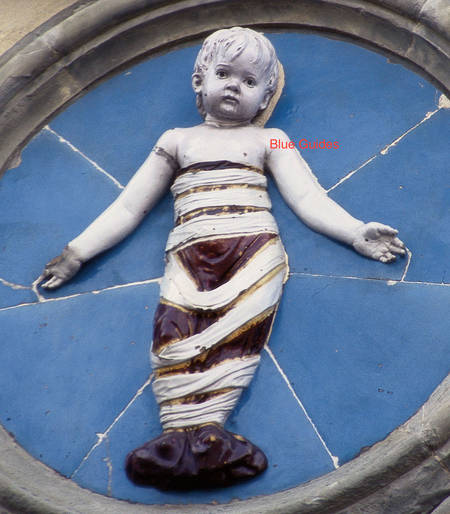
The museum space has been expanded into the basement of the building where the history of this remarkable Institute is clearly recorded (also with the help of video installations). Opened in 1445, it was the first foundling hospital in Europe, where destitute mothers could take their babies (leaving them at a special window under the portico, without being seen) The babies were then given out to wet-nurses, and when weaned could return to live here. The orphanage was recognised in later centuries as one of the most up-to-date institutions of its kind. One of the most touching parts of the museum is a room where cupboards have been installed with 140 little drawers which you can open one by one to see the identification tags left with the babies by their mothers in the hope that one day they would be able to be reunited with them. These anonymous ‘messages’ take the form of jewels, keepsakes, notes, pieces of cloth, rosary beads, coral, etc., and all of them were carefully preserved in the Archive of the Institute under the name of the child given to him or her when they entered the Innocenti.
On the ground floor is the exquisite 15th-century oblong cloister (derived from designs by Brunelleschi) next to the larger cloister decorated in the following century. The works of art are still exhibited in the long gallery once used as a day nursery on an upper floor. The masterpieces here are Luca della Robbia’s white enamelled terracotta Madonna and Child and Domenico Ghirlandaio’s painting of the Adoration of the Magi, which includes two of the “Innocenti” foundlings in the foreground. There is access to the roof terrace, once used for drying laundry and subsequently for the nurses and children to take the air, and now a delightful café. All the new stairs and constructions in the museum are in good taste (except perhaps for the golden entrance and exit in the Piazza).
Since the reopening of the Museo dell’Opera del Duomo last year, the reopening of this museum is a significant event, demonstrating that Florence is now at the forefront of museum design.
by Alta Macadam, author of Blue Guide Florence.